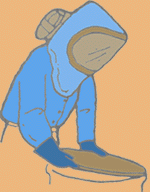
PERSONAL PROTECTION AND SAFETY
There are four ways by which hazardous materials can invade your body. These are known as the routes of entry:
At this level of training, absent Personal Protective Equipment and a higher level of training, the only tactic to be used would be defensive. Awareness level training is designed to give those "first on the scene" better control through defensive conduct to prevent unnecessary exposures to chemicals and resultant injuries through the above routes of entry.
Full Protective Clothing
Full protective clothing includes the helmet, self-contained breathing apparatus, coat and pants customarily worn by firefighters (turnout or bunker coat and pants), rubber boots, gloves, bands around legs, arms and waist, and face mask, as well as covering for neck, ears, and other parts of the head not protected by the helmet, breathing apparatus or face mask.
Special Protective Clothing
Special protective clothing refers to clothing specially designed to protect against a specific hazard. Special protective clothing is classified into four levels, A,B,C and D.
Level A - Highest level of respiratory, skin and eye protection.
Recommended Equipment:
Level B - The same level of respiratory protection, but less skin protection than Level A.
Level C - The same level of skin protection as Level B, but a lower level of respiratory protection.
Recommended Equipment:
Level D - Lowest level of protection. No respiratory protection. Other equipment as needed to safely handle the material (gloves, goggles..)
DECONTAMINATION CONSIDERATION:
www.hmep.com